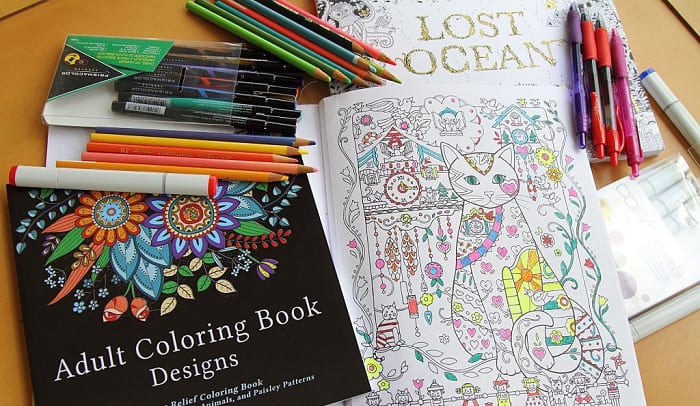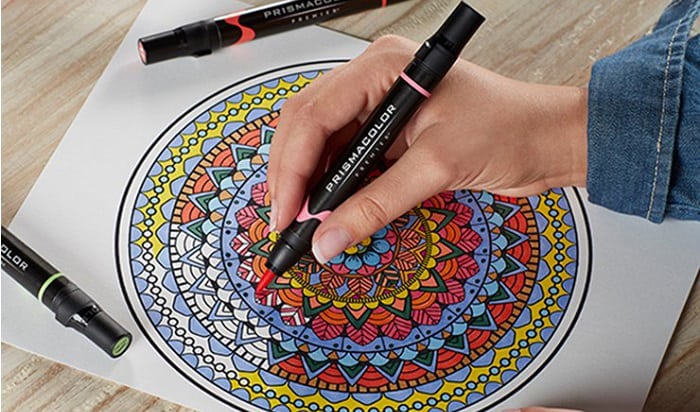Apart from its colored pencils, Prismacolor is also popular for its line of blending markers. Its “Scholar Art Markers” feature low-odor water-based inks.
Meanwhile, the Premier markers come in a wide variety of variants. With 200 colors, the double-ended art markers sport a fine tip on one side and a brush or chisel tip on the other.
Not to mention, the brand also offers fine-tipped illustration markers.
I assure you that you don’t need all 200 colors for this Prismacolor marker tutorial if you’re just starting out. You can bring out new hues by blending two or three markers!
Table of Contents
Prismacolor Techniques for Beginners
What You Need
1. Prismacolor blending marker set
Since this tutorial only tackles blending basics, you can use either the brush or chisel tips.
While both are great for coloring large surfaces, the brush tip lets you reach tight spaces.
2. Cardstock or marker paper
Cardstocks are heavy-weight papers that are normally used for card-making, business cards, postcards, or crafts.
In terms of thickness, marker paper sits somewhere between cardstock and printer paper. Plus, its surface is coated.
Both cardstocks and marker papers are smooth, allowing the artist to blend the ink smoothly.
3. Scrap papers
Although cardstocks and marker papers are thicker than printer papers, it is best to protect your desk or the entire sketchpad against bleeding.
For this tutorial, prepare a few scrap papers to be placed under the sheet that you will be working on.
4. Black fine-tipped marker or gel pen
Gel pens and fine-tipped markers are among the most versatile creative tools. You can use them to write, sketch, or draw outlines to emphasize certain objects in the illustration.
5. Pencil and eraser
If you are not confident with your sketching skills, I highly recommend creating pencil outlines before laying down the colors with markers. This will allow you to erase and give the drawing another try.
6. Plastic palette or any flat surface made of plastic
Plastic palettes are available in most arts and crafts shops. However, you don’t have to buy it if you don’t own one.
You can use a plastic plate or a sheet of acetate in place of the palette.
1. Swatching colors
A marker’s color will not look the same when used on different types of paper. You will notice that the same marker appears darker on one paper and lighter on the other.
Due to these discrepancies, it can be difficult to plan your next masterpiece by just looking at your markers. Likewise, it can be time-consuming if you watch each time you need to work.
Thus, many professionals, including manufacturers like Prismacolor, recommend swatching colors after buying a set of drawing tools.
Before we begin the Prisma markers tutorials, let’s create some swatches by following the steps below!
That said, feel free to skip this and proceed to the next tutorial if you have already tested each color.
- Get a cardstock or marker paper and write down “Prismacolor markers” at the top with a pen.
If you own markers from different brands like Copic and Tombo, labeling the page with the brand name will be useful when you need a reference for colors in the future.
Having a dedicated page for each brand in your sketchbook lets you find specific swatches faster.
- Start by writing down the name and code of each color on the cardstock. You can find the name and code in the maker’s body.
For those who are not familiar with Prismacolor, the color code is a sequence of letters and numbers to identify the specific tone and shade of a hue.
For instance, the Prismacolor yellow marker is named “lemon yellow” while the code is “PC915.”
Be sure to leave some space below the name and code.
- Start laying down the corresponding colors in the space below the name and code. Prismacolor suggests applying light and dark tones by adjusting the pressure.
Each artist has his or her unique way of creating swatches and charts. I highly recommend watching NerdEJackie and Include a Thank You to get ideas.
2. Basic coloring
- Pick one colored marker and draw two lines on a marker paper or cardstock. You can use Prismacolor markers’ brush or wedge tips.
With line #1, try to maintain the same amount of pressure for the moment the nib touches the paper until you lift the pen.
As for line #2, press the nib harder while drawing, then lighten the pressure towards the end.
Here, you will notice the difference: Line #1 shows a more even color than line #2.
- Now, pick up your pencil and draw a rectangle on the same paper.
To fill it with color, draw multiple lines next to each other, applying the same amount of pressure as you did with line #1.
You can swipe back and forth to fill the space, as demonstrated in this video. This should give you a smooth flat color with no gradients.
If you see some streaks, you can reapply the marker to even out. However, if you started shading by going left to right, try going up and down this time.
This technique will help you even out the color.
Alternatively, you can also add more layers on one side to make it darker. In many tutorials on how to color with Prismacolor markers, this is often called “layering.”
- Draw another rectangle with a pencil, and this time fill the shape using the technique you did with line #2.
You can do this by starting from the left side of the rectangle. Just make sure that the pressure you apply on the left side is heavier. Then lift the pen at the end.
Continue doing it until the shape is fully colored. Unlike the first rectangle you made, this one produces a gradient effect.
According to Youtuber and artist Katie Croonenberghs, this is called the “feather method.”
You can even continue shading with another marker from the same color family. For instance, if you picked yellow earlier, you can try orange.
Just repeat the process but this time, go from right to left. Somewhere in the middle, you will see the two colors meet and blend since the inks are still wet.
Tip: To improve your control, practice these basic Prismacolor markers techniques repeatedly. It can take days, weeks, or months before you perfect it.
If you are getting bored with rectangles and squares, you can try other shapes like circles, hexagons, hearts, stars, or even basic face drawings.
3. Palette blending
- Using the brush nib, apply color to the plastic palette until you see a small pool of ink forming on the surface.
Next, take another marker from the same color family. Alternatively, you can also select complementary colors.
For example, if you applied red ink to the palette, you can choose green to blend it with. Anyway, don’t limit yourself to my suggestions, and feel free to experiment!
- Dip the second marker’s brush nib onto the pool of ink on the palette. Think of it as if you’re picking up another color with the nib.
Once you do this, you will notice that the brush’s tip slightly darkens. Get a piece of cardstock or marker paper and start drawing a line.
As you can see, the line changes its color as you drag the marker.
If you dipped the blue marker’s nib on green ink, then you will produce a line that goes from green to blue. As it transitions, you will notice a blue-green shade in the middle.
Tip: Among the Prismacolor markers drawing techniques, this one is most suitable for brush nibs but feel free to try it with the fine and chisel nibs.
Furthermore, this method is useful for various applications. Just check out Amy Latta Creations to learn how she created a hand lettering project.
Conclusion
Although this is the end of my Prismacolor marker tutorial, this may just be the beginning of a new creative endeavor for many of you!
To keep you from getting overwhelmed, I made sure to share the basics only. Rest assured, these techniques will help you improve your coloring. Plus, they are also applicable to more advanced and complex illustrations.
Just continue to practice as often as you can and you will surely see huge progress over time.

Art has always been a part of my life; it influences my upbringing and later my career choice. For me, it is always a part of my parenting technique. So for whichever purpose that you come to art, you can start here with us.


